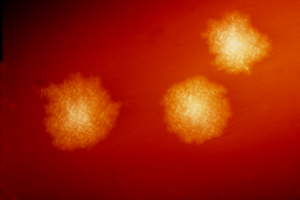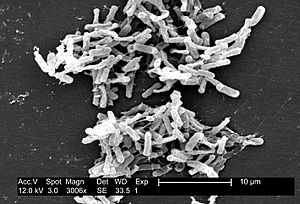Clostridioides difficile facts for kids
Quick facts for kids Clostridioides difficile |
|
|---|---|
 |
|
| C. difficile colonies on a blood agar plate | |
 |
|
| Electron micrograph of the bacterium | |
| Scientific classification | |
| Genus: |
Clostridioides
|
| Species: |
difficile
|
| Synonyms | |
|
|
Clostridioides difficile (also known as Clostridium difficile or simply C. diff) is a type of germ, or bacterium. It is well known for causing serious tummy problems like diarrhea. It might also be linked to colon cancer.
C. diff is a Gram-positive bacterium that can form spores. These spores are like tiny, tough seeds that help the bacteria survive. Clostridioides bacteria live without oxygen and can move around. They are found almost everywhere, especially in soil.
When you look at C. diff under a microscope, they look like long, irregular rods. They often have a bulge at one end. They grow best in warm places, like inside the human body.
C. diff can make up to three types of harmful substances called toxins. These toxins are what cause people to get sick. When the bacteria are under stress, they make spores. These spores can survive harsh conditions that the active bacteria cannot.
C. diff is a growing concern for human health. In 2017, in the United States, there were over 223,900 cases in hospital patients. Sadly, about 12,800 people died from it.
Even though C. diff is often linked to hospitals and antibiotic use, many infections happen outside of hospitals. Also, only a few specific antibiotics are strongly linked to a higher risk of getting a C. diff infection. These include clindamycin, fluoroquinolones, and cephalosporins. Many other things can also increase the risk, like using stool softeners.
Sometimes, C. diff can live in a person's colon without making them sick. These people are called carriers. They don't have symptoms, but they can still spread the bacteria. Carriers are thought to be a main way the infection spreads.
Contents
What is C. diff?
Pathogenic C. difficile strains produce several toxins. The main ones are toxin A and toxin B. These toxins can cause diarrhea and inflammation in the colon. This condition is called C. difficile colitis.
The diarrhea can be mild, or it can be very severe. In serious cases, it can lead to a life-threatening condition. This condition causes intense inflammation and forms a protective layer in the colon. The toxins harm the cells in the colon, leading to these problems. C. diff also makes a chemical that stops other germs from growing. This helps C. diff take over in the gut.
Treating C. diff infections can be hard. This is because the bacteria can resist some antibiotics. Also, the bacteria can form spores and create protective layers. A new, very strong strain of C. diff that resists certain antibiotics was found in 2005. This strain caused outbreaks in North America. Scientists are worried about new strains that are stronger or harder to treat.
How C. diff Spreads
Clostridioides difficile spreads from person to person, or from animals to people. It spreads through contact with infected faeces. The bacteria form spores that are very tough. These spores are not killed by alcohol-based hand sanitizers. They also survive regular cleaning.
This means the spores can live on surfaces for a long time. Things like toilets, bathtubs, and medical tools can become contaminated. If someone touches a contaminated surface and then touches their mouth, they can swallow the spores.
Once swallowed, the spores can survive stomach acid. They then grow into active bacteria in the colon. This is why washing hands with soap and water is very important. It helps stop the spread of these spores.
People are more likely to get C. diff if they have had other tummy problems. For example, food poisoning or using too many laxatives can make someone more likely to become a carrier. People who don't have a history of tummy problems might not become carriers even if exposed.
Once someone becomes a carrier, they can carry C. diff for years. The amount of bacteria they shed can change daily. Sometimes it's low, sometimes it's high. Tummy upsets in carriers can cause them to shed more bacteria. This makes it easier for the infection to spread.
Who Can Get C. diff?
Clostridioides difficile can infect pigs, calves, and humans. It lives naturally in soil, animal and human faeces, and sewage. It can also be found in the human gut and on retail meat.
A study in 2015 estimated that C. diff affected almost half a million Americans in 2011. It caused about 29,000 deaths. The study found that many cases started in nursing homes or community health centers. About 24% of cases happened in hospitals.
C. diff is common in the human digestive system. However, it is usually kept in check by other good bacteria. If antibiotics kill off these good bacteria, C. diff can grow out of control.
Symptoms usually appear 5 to 10 days after antibiotic treatment. Young children often carry C. diff with high levels of toxins. But they rarely get sick from it. Just having the toxins is not always enough to cause symptoms.
Signs and Symptoms
If someone has a C. diff infection, they might have these symptoms:
- Diarrhea (at least three loose bowel movements a day)
- Dehydration (not enough fluids in the body)
- Abdominal pain (tummy ache) that can be severe
- Loss of appetite
- Nausea (feeling sick to your stomach)
Treatment
If someone starts having symptoms while taking antibiotics, they should stop taking them if possible. Sometimes, stopping the antibiotics can make the symptoms go away.
If symptoms don't go away, doctors will use specific antibiotics to kill C. diff spores. The main treatment for a first infection is usually vancomycin. This medicine has replaced metronidazole because it works better and has fewer side effects. Another option is fidaxomicin, which can work even better than vancomycin.
About 20% of patients who get treated for C. diff will get the infection again. Some people might have it come back many times. If the infection comes back, doctors might try a different treatment plan. This could involve taking vancomycin in smaller, decreasing doses over a longer time.
Each time C. diff comes back, it can be more serious. Long-term treatment with vancomycin, along with probiotics like Saccharomyces boulardii, can help.
For repeated infections, doctors might use fidaxomicin. This antibiotic is very effective but can be expensive.
If traditional antibiotic treatments don't work, a fecal microbiota transplant (FMT) might be an option. In this procedure, healthy stool from one person is put into the colon of a patient with repeated C. diff infections. This treatment is very successful, with a high cure rate. It is very good at treating long-lasting C. diff cases. However, sometimes it can cause other tummy problems. The long-term effects of FMT are still being studied. If FMT is not possible, removing the infected part of the colon can also cure the infection.
Types of C. diff
In 2005, scientists found a specific type of C. diff called BI/NAP1/027. This strain was very strong and caused many outbreaks.
By 2016, new types of C. diff started to appear in some areas. These new strains, like NAP2 and NAP4, began to replace the older NAP1 strain.
Two specific types, RT078 and RT027, can grow well on low amounts of a sugar called trehalose. These types became more common after trehalose was added to many foods in the early 2000s.
Studying C. diff's DNA
Scientists have studied the complete genetic code (genome) of C. diff. The first full genome was published in 2005. It was from a strong, drug-resistant strain. Scientists have continued to study many different C. diff strains. They use advanced technologies to read the bacteria's DNA. This helps them understand how C. diff works and how to fight it.
Viruses that Infect C. diff
There are also viruses called bacteriophages that infect C. diff bacteria. Scientists have found at least eight different types of these viruses. These viruses can be found in C. diff from both the environment and sick patients.
See also
 In Spanish: Clostridioides difficile para niños
In Spanish: Clostridioides difficile para niños

